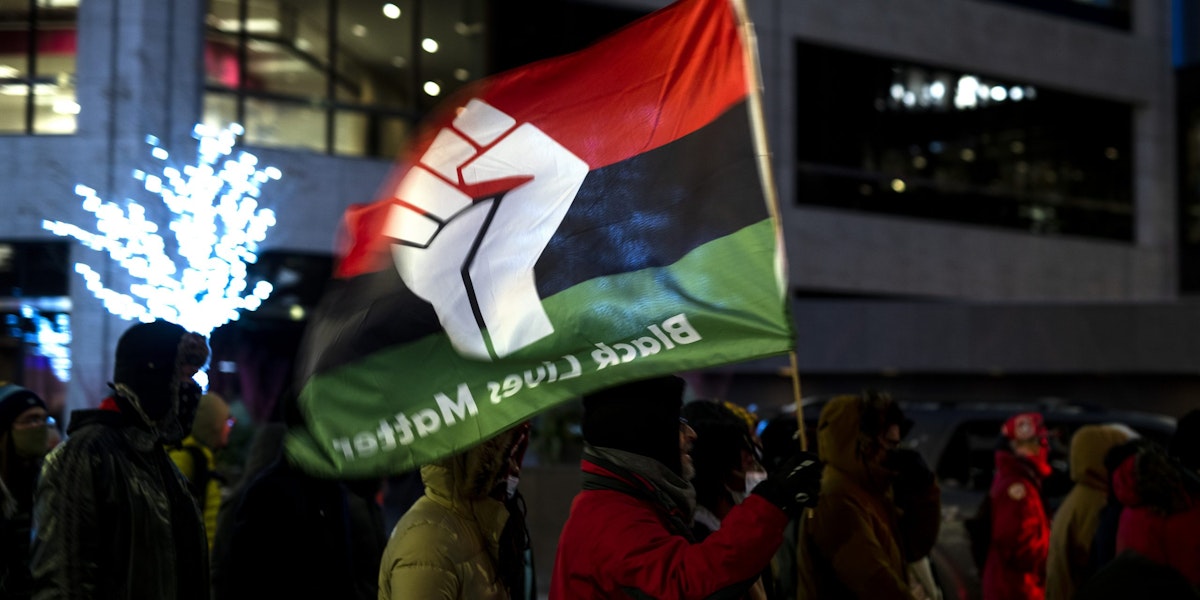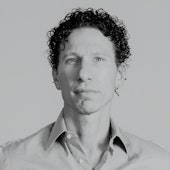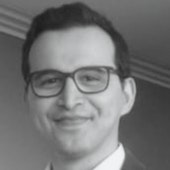A growing cross section of societies around the world has taken to the streets in the past few years to challenge systemic injustices, from corruption to a lack of basic services to racial inequity. These mass mobilizations have been particularly prominent since 2019. Protests have significantly shaped political narratives, especially in the Middle East and the United States.
One of the key challenges for activists is to harness the political energy of mass protests—to go from protesting to organizing. The decline of traditional organizations and the rise of new communications technologies and social media have changed the conditions under which protests evolve from mobilization into movements. The transformed information environment provides both opponents and states with new tools. At the same time, civic spaces are closing down, and state security often responds to protests with a heavy hand. As a result of all these factors, building movements can be harder than in the past.
On the other hand, movements enjoy rich opportunities to learn by working across generations, regions, and with other movements. Often, though, activists must go out of their way to foster such learning, because popular protest movements lack the robust institutional memories of states and regimes.
In this roundtable, seven activists, researchers, journalists, and trainers discuss the challenges facing contemporary protest movements. Some roundtable participants work on specific countries (Iraq, Lebanon, Algeria, the United States), while others have a global perspective. Their exchanges reveal that, while the stakes and risks associated with protest vary across regions, there are similarities: Both democratic and authoritarian regimes use a similar range of tools, including the law, to cripple movements. Regimes also use co-optation strategies to mute movements. At the same time, protest movements increasingly learn from the experiences of counterparts in other countries, adapting techniques and strategies from one national or regional context to another—especially in the critical challenges of building political infrastructure and a movement ecosystem.
The discussions in this roundtable represent the views of the participants and do not necessarily reflect the positions of The Century Foundation.
From Protests to Movements
Ivan Marovic: We’re in the midst of a long-term trend not just of political party decay but also of decay of traditional organizations in general. When I was participating in protests in the 1990s, trade unions, neighborhood associations, and even football associations were all strong and would take part. This is less and less the case. Society is more atomized. But I’ve also seen much more connectedness. It’s much easier to get the message across, which has to do with technology.
When we were organizing in the 1990s, we were thinking about an underground printing press and how to get access to media—how to get a photo in a newspaper, or whether international publications would run a story. In the past, there was the slow work of organizing through nongovernmental organizations (NGOs), political parties, and trade unions. These entities build relationships, and they invest in human resources, second-tier leadership, and operatives that can run a show in a local town or neighborhood, and can organize a rally. On the other hand, a lot of ad hoc organizing was happening in protests, and based on informal structures, without relying on these organizations.
To move from a protest to a movement, you need to build organizational capacity—but without transforming into a traditional organization. Movements are long-term organizational entities that have both structure and the ability to mobilize outside of that structure. An example of such a movement was Solidarity Poland in the 1980s, which had 4.5 million members. And in South Africa in the 1980s, there was a coalition of three hundred NGOs and grassroots organizations.
Today, things are quicker, and the lack of organization is a big vulnerability for protest movements. Protest movements are more protest than movement. And the transition to a movement—to something more strategic, long-term and intentional—really keeps me up at night. A lot is based on short-term mobilization, and people are having a lot of difficulty moving from mobilizing to organizing. It’s not that we used to be able to do it, and now we can’t. It’s that the situation is different today, and adversaries have many more capabilities.
Thomas Carothers: Life is changing in the way people relate to each other and to society. In large part, this is because of technology—people have different kinds of attachments than they used to. If we think of protest as an alternative to political parties or a different way to seek representation and change, maybe the whole model of political life is shifting. We don’t have strong trade unions anymore, and political parties are weak in most places, unless they are dominant parties. Individuals feel a lot of cynicism toward their governments. They don’t feel strong attachments to many institutions. So maybe protests are more than just protests—they’re the way people associate and try to get themselves represented. If we see protest more as a successor to traditional forms of political representation, they are less something that needs to be solved than they are a way of life.
Nicole Carty: At Momentum, a training institute and movement incubator where I am on the leadership team, we’ve done some research looking at what the conditions for huge policy shifts in the United States are. Historically, it’s happened a few times—the New Deal, the realization of a lot of the constitutional amendments prompted by the Civil War, Reconstruction. So there were a few key moments when there were great shifts in the public, and U.S. government power was wielded very differently. Underlying these moments were strong, organized structures of protesters and movements. The movement to abolish slavery, for example, pursued its aims through the Civil War. After the Civil War, the abolitionist organizations were dismantled or fell apart; Reconstruction was pushed back; and then entities with vested interests in white supremacy were re-enshrined. Something analogous happened with the New Deal. Labor was organized and pushed Franklin D. Roosevelt to create all of these policies. Then, the Right purposefully deconstructed the labor movement, and regressive interests regained their power. The existence of strong movement infrastructures is a determining factor in what political parties do—and what ultimately happens in government.
Ivan: We have the tools to replace traditional media, but we don’t have the tools yet to replace traditional organizations. However, new technology and traditional organizations are not incompatible. In the mobilizations in Sudan that began in 2019, protesters relied on professional associations and trade unions who did a lot of the heavy lifting and mobilized working classes—despite the availability of all these new technologies, the bulk of organizing was still old school, in-person, and network based.
Nicole: There was a lesson we learned through the Occupy movement: when movements were erupting in reaction to polarizing events, it was hard to bring the knowledge and the previous work and synthesis of past movements to people who were being energized for the first time. When you’re riding on a high, the last thing you want to hear is someone saying, “I have been here before, it is going to go this way, and you need to do this thing.” This inability to implement learning led to downstream consequences. And within months, we started seeing internal structures disintegrate, and a lack of clarity around resources.
The movement cycle adopted from Bill Moyers’ Movement Action Plan is a really good tool to explain where this phenomenon comes from. First, there is an issue brewing, and more awareness coming and building around an issue. Then, a trigger event sets everyone off. And suddenly there is action all over the country. In the honeymoon phase of a movement, you feel that you have won. But then, problems begin to creep in, and the movement doesn’t obtain its objectives. The movement begins to drop off, and there is disillusionment.
No matter what the movement is, there are things you can do to recognize this cycle and make an intervention. This includes knowing that you’re going to have high and low moments, and building a structure that uses the energy during the honeymoon phase to achieve a particular aim.
At Momentum, we began to try to figure out how to build structures that can transform and help generate trigger moments—but then also transform that into policy. We began training people to understand movement dynamics and to make meaning of their own experiences. But we also began to incubate movement organizations, helping them to build structures that could create and absorb the energy from the honeymoon phase. We also tried to create a healthy culture within these organizations that prioritizes transparency and protects against infighting, making them more resilient.
Jean Kassir: The American University of Beirut (AUB) Secular Club and the Mada Youth Network in Lebanon are case studies for thinking about protests and movements, and the interplay between them. These are some of the very few long-term efforts to build grassroots infrastructure in the opposition in Lebanon. Universities are fertile ground for nonsectarian progressive politics, mobilizing around interest-based rather than sectarian politics. This was particularly the case at AUB, which has a history of progressive politics. The AUB Secular Club was created in the context of mounting sectarian polarization, which culminated in the May 7, 2008, attacks launched by Hezbollah against its political rivals in Beirut. The AUB Secular Club was made up of people who were born in the 1990s, who had not lived through the Lebanese Civil War, but were subjected to all its repercussions. Mada was set up in 2017 as a network of secular student clubs and alumni, and is based on the principles of secularism, democracy, social justice, and gender equality. The structure is horizontal, and the decision-making process is highly participatory.
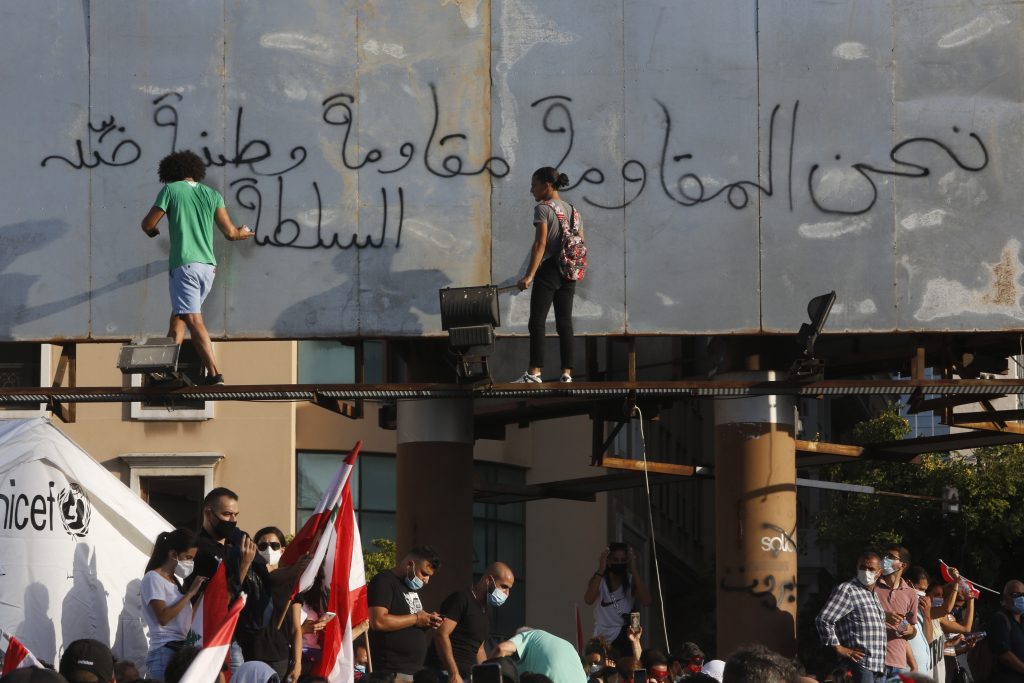
The growing popularity of the Secular Club came from its adoption of a student-centric discourse—in contrast with the political parties that engage with student politics using sectarian rhetoric, but don’t deal with day-to-day student concerns. The pitch to students was that everything that political parties are selling you is not benefiting your everyday lives—your tuition fees are increasing, and you don’t have a say in the way the university is managed. The Secular Club gained prominence by winning seats in the student council and by leading student strikes. When the model succeeded, it was replicated by other students across the country. Student politics was the entry point to engage in antiestablishment politics, but the rationale was to try to get students to think in terms of the broader picture—the sense that what brings them together as citizens is suffering from the economic system and the instability caused by the warlords (who benefit from this instability). This rhetoric was crystallized by the economic collapse after the uprising of October 17, 2019, when it became clear that the political class were only concerned with protecting their interests, regardless of their sect.
As the Secular Club was growing, other antiestablishment Lebanese movements also grew, in response to the garbage crisis of 2015 and following the municipal elections of 2016, when the antiestablishment campaign secured nearly 40 percent of the votes in Beirut. The idea of Mada developed in this context, as a platform that allows students to get out of student politics and to have a say in national politics. Mada was also seen as a mechanism for transferring skills between generations and ensuring political continuity, and as a platform that would have a role in future mass mobilizations.
Thanassis Cambanis: The experiences of the AUB Secular Club and the Mada Youth Network make me wonder how we might be able to involve a broader spectrum of class participants in these movements. There is an assumption that if you want to lead to real change, then you need a party or a trade union, or you need to influence existing parties and unions, because these are avenues into power. Trade unions in the Arab world and beyond are often totally reactionary. They are not natural allies for a reform movement, much less any revolutionary movement. This is changing in some contexts—in the United States, some trade unions have been open to joining forces with Black Lives Matter. However, established political parties and trade unions run the gamut of political views—some are reformist, some favor the status quo.
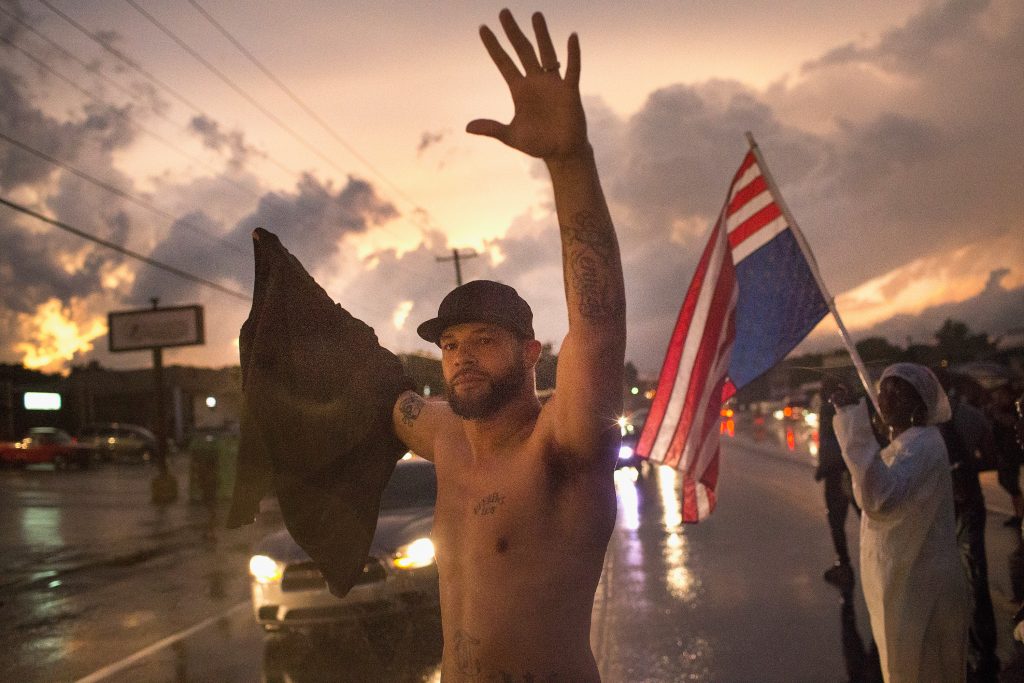
Ivan: The “pillars of support”—a framework used at the International Center on Nonviolent Conflict—offers a useful way to think about these questions and to strategize. The model holds that power operates through institutions and organizations; when we withdraw support for those institutions and organizations, it weakens them and weakens the power-holders they prop up. Some of these pillars are officially part of the state and execute policies directly, some are more like institutions of civil society and create a wider environment for these policies (an environment which, as Gramsci tells us, perpetuates cultural hegemony). In a sense, the theory of change, in general, is about mass mobilization over a long period of time. Through increased citizen participation, you weaken these pillars, and this is how you actually change the system. You have to look at each pillar separately. You don’t look at them together as “capitalism,” for example, but you actually look at which pillar performs which function and how you can weaken it.
You weaken it in different ways. As Thanassis says, the trade unions in the Middle East are often reactionary. Sometimes, you cannot co-opt them because they’re too reactionary. What do people do then? They build alternative institutions that challenge the reactionary institution. In Serbia, we built the independent trade union movement, so every factory had two trade unions— the official one, then the independent one. On the other hand, sometimes you can co-opt these institutions. Negotiation is another option—you can actually cut a deal with the existing leaders of the institutional organization in question. But just as they negotiate with you, they can negotiate with someone else later. Building “entryism” is another tactic. (Entryism refers to the infiltration of a larger group by a smaller group.) That same strategy can work with elections, when you bring your own candidates into the elections of the existing bodies and you slowly take over. I actually think that this was the biggest impact of Occupy Wall Street to this day: entryism into the Democratic Party.
It’s an important moment when a movement goes beyond being against the system in a puritan way, and thinks more about political strategy. The movement operates outside of institutions, inside institutions, against institutions, around institutions—and you figure out different approaches in different circumstances. I think the pillars of support is a really good framework that offers that insight—how you build your power, both inside institutions and outside institutions, against institutions, and through co-optation or negotiation with different institutions and organizations.
Jean: In terms of the theory of change, we thought that if we managed to create successful alternative political spaces that bring together people from different sects and regions, it would already be a success story and a proof of concept that could then be expanded. The first step in dismantling the regime is creating social transformation, and imposing a new social reality that redefines social, economic, and political ties between people in a way that breaks with the regime’s sectarian structure. This happens by creating a grassroots political infrastructure, so that people have room to organize around interests rather than on a sectarian basis.
The decision for us to now engage in electoral politics is not about revising our theory of change—we still believe power is not in parliament and the regime cannot be defeated by institutional politics. Engaging in electoral politics is pragmatic, perhaps in the way that Ivan is talking about. It’s about allowing our ideas to reach more people through national elections, and to mobilize more people across Lebanon. In other words, how we approach the question of institutional politics versus alternative politics is more pragmatic than ideological.
Institutions have also been created, in line with one of the strategies that Ivan is talking about. In 2017, some of the activists who created the Mada Youth Network also created the media outlet Megaphone. Although the projects are separate, the key idea behind both was to build structures that can counter the establishment’s narrative and to radicalize the opposition’s narrative. At that time, the opposition had a very bland anticorruption rhetoric that wasn’t going deep into the conversations that were the real fault lines in Lebanese society.
The rationale for creating Mada and Megaphone was very clear: we needed structures that could help us gain leverage whenever the next big protests occurred. We were proved right when the protests happened in 2019—there was a media outlet ready to cover the protests in a way that broke the monopoly that mainstream media has on images and narratives. And there was a nationwide youth network ready to mobilize on the ground.
The Lebanese opposition has failed, on many occasions, to use political momentum to make a breakthrough, because we lacked the political infrastructure to do so. The movement that created the Secular Club and Mada tried to bridge that gap. The movement already existed before mass mobilizations. It was involved in mobilizing in the streets and remained after protests subsided.
Ivan: In building movements, it is also important to be very careful about how we think about leadership. There are spokespeople and there are leaders. Martin Luther King, Jr. was a very charismatic leader, but there was collective leadership behind him. There is hierarchical leadership and structure on the one hand, and there is collective leadership. What’s new today is fluid leadership. A pitfall of fluid leadership can be that, when a movement does not create its own leaders, the media does it. Social media also picks leaders.
Jean: In Lebanon’s protest movement, there are different kinds of leadership figures that have emerged. There are the opinion leaders active on social media. They’re not necessarily active within political organizations—they could be independent activists, comedians or bloggers—but they actually influence where people stand.
Then you have another set of leaders—those who could become minister in a transitional government. They exist mostly as media figures and are largely fueled by TV. These leaders don’t all have wide, grassroots legitimacy, but can play the role of the alternative politician for the media.
Then there is the leadership dynamic within our groups, mostly the new Left, grassroots and feminist circles. There is this idea that we are against all forms of hierarchy and pyramidal structure, but hierarchy often develops anyway, due to seniority, experience, or even some people’s charismatic personalities. The latter is much worse than a planned hierarchy: it doesn’t have legitimacy, it’s not mandated by any vote or equivalent, and it opens the door to all kinds of abuse even with the best intentions in the world. Then, on the one hand, you don’t have the mandate to move things forward quickly—which is important at times of crisis—and at the same time, you have people who have more weight than others, so you end up with a messy situation. The nonhierarchical model came as a reaction to the bad experiences with authoritarian and patriarchal party structures that are prevalent within the Lebanese Left. It also came from a political and ideological need to reinvent our political spaces in a way that resembles our value system and aspirations. These new structures do not always play out in an efficient way. And in fact, everyone is now reconsidering those structures. They don’t want to go back to a more classical scheme, but instead would like to improve the structures and make them more efficient in times of crisis. Questions related to efficiency and rapidity in decision-making have resurfaced, at a time when the country has reached rock bottom.
How Movements Learn
Nicole: When Occupy Wall Street broke out, it was the first time that my generation had seen this kind of movement activity in the United States. Occupy was successful in changing the conversation around inequality. However, Occupy was also messy in many ways. There was a lack of clarity about what the movement was about: Was it trying to make a political intervention? Was it a prefigurative example of what the world should be? There was a lack of alignment as to what our one demand was supposed to be. A lot of resources went into maintaining the occupation itself, instead of wielding the power that we had created politically. That tension and that unresolved question within Occupy led to its internal demise. And of course, there was state repression from the police and a crackdown on occupations across the United States.
After Occupy, a lot of people who had been involved continued to think about what this work did, and if Occupy would happen again, what we would do differently. We then implemented our learning in the Occupy Sandy relief effort in the wake of Hurricane Sandy in 2012. Since the same people who were mobilized in Occupy Wall Street were mobilized for Occupy Sandy, we were able to build and develop Occupy Sandy to be more strategic. We also had a lot of networks and infrastructure from Occupy Wall Street—we had the digital infrastructure from Occupy Wall Street, and that was part of what made Occupy Sandy so successful.
Occupy participants were also thinking about how to systematize their knowledge. We began to come together and created Momentum. We had all been in movements but didn’t have shared languages, and Momentum trainings began to give us that, and to think about how to make better interventions in the future. After the first Momentum training in 2014, the Movement for Black Lives erupted. At this point, there had been years of infrastructure laid from Occupy—networks, relationships, and movement theory that the Movement for Black Lives built on. Movement participants had seen what had succeeded and failed in Occupy, and there was a lot in common structurally between the Movement for Black Lives and the decentralized nature of Occupy.
Hicham Yezza: I’ve been a participant in or observer of social movements for almost thirty years, and I am often struck by the incredible amount of learning—and I don’t just mean across generations but also from one context to another. But just as often, I am struck by the lack of learning. All it takes is for fifteen years to pass and people are reinventing the same arguments and debate. I am interested in why, in some cases, participants fail to learn the lessons of the very recent past.
My experiences in the UK and Algeria have led me to think that sometimes there is a failure to learn lessons because the same people who are playing a key role in protests now are also those who were there in earlier periods. This has not always led them to learn from the lessons of the past—in fact, it can have the opposite effect. When people bequeath the learning of how to sustain and build a movement, they may also pass on the seeds for its fragmentation.
The other reason that protests fragment has to do with scale and time. Of course, the institutional memory of an authoritarian regime is much more robust and resilient than the learning capabilities of protest movements. And that is a key structural dynamic. Movements don’t necessarily have formal repositories of institutional or collective memory. They seem to be far less able to sustain learning. Protest movements think about hours, days, and weeks, whereas the scale at which systems think is in terms of decades and centuries. We have time working very differently on the two sides. And when I say “time,” I also mean everything else that comes with it, like resources and energy. In this context, the political elite use a strategy where they are just able to wait out protests until they fragment. Is this something that is inherent to protests and is always going to happen?
Jean: With the Secular Clubs and Mada, it was very important for us to intentionally create continuity through the ability to transfer skills between generations and to maintain contact with older generations of leftist activists and student activists. This was formalized in organizational mechanisms through discussions, workshops, or by allowing the older generation—AUB alumni, for example—to have an advisory role in a new initiative or entity that we created. They were also able to fill the gap that students couldn’t fill at the level of organization and experience.
Tom: What’s daunting about what you described, Nicole, is the array of different movements and goals that are all loosely connected. This has the potential to be a source of strength, but it obviously also has the potential to be a source of weakness. I’m puzzling over that a bit. In a way that’s the whole modern history of progressive movements in the United States since the 1960s. They are different movements traveling in similar directions, but not joined up. I’m always comparing this to the Right, and how the Right always seems to be more focused. I don’t know whether this focus is a result of them having narrower circles and blocking things rather than advancing things. But I wonder if you could comment a little bit more on that.
Nicole: Historically and to this day, there has been a divide-and-conquer strategy in response to progressive activism. We see it in the way that, for example, campaigns for racial justice are pitted against gender justice. We have terms like intersectionality that are useful but are not really being lived in a deep way.
I think that a lot of these movements do mobilize the same people. There are people who are mobilized for Black Lives Matter, Occupy, and the Women’s March. Then, there are also parts of each of these movements that are deeply critical of other people.
Since 2011, movements have become acceptable for a growing number of people. You could look at two different periods—one before the rise of Donald Trump, and one after he was elected president. Black Lives Matter and Occupy were thought of as fringe movements. They were popular and widespread, but were viewed as radical and political. Then, after Trump was elected, the idea of participating in movements became more mainstream.
There are those on the left who criticize late joiners to the resistance, because they have different politics than the founders. But instead, they could view these new resistance activists in a more positive light—as evidence of a growing number of people on our side and evidence that we’re winning. The tendency to criticize people who more recently joined the movement acts as a barrier to growth and transformation. There is no infrastructure or education to move people into alignment or help them patch up those differences. People also have different ideas about what the root of the problem is—some people say it’s class, others say it’s racism. The Right exploits these fault lines.
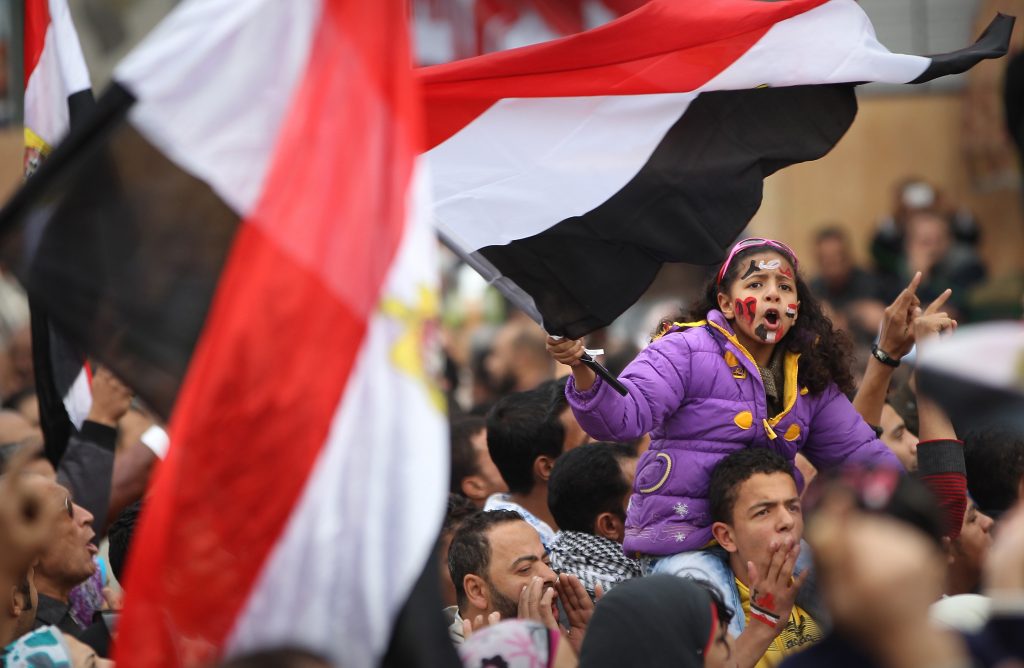
Thanassis: There’s an inherent tension within protest movements that spring up as spontaneous reactions to an authoritarian regime, or to a trigger event: the draw of the protest is inherently local and feels specific and organic to the participants. So there can be a tendency, especially among new adherents to a protest movement, to avoid drawing on the examples of other movements. In Egypt in 2011, during the Tahrir Square protests and then the year and a half of political competition that followed, many of the anti-authoritarian protesters rejected “politics” as inherently tainted—as if to seek power in any form would compromise the purity and legitimacy of the protest. I encountered some similar views among Occupy protesters in the United States, and later, some of the activists who took an absolute approach during the Black Lives Matter protests. In effect, the people within a protest movement who want to draw on the lessons of other movements or historical cases, or who want to engage with politics or other powerful decision-makers, can encounter a stigma. They might be labeled as sellouts or compromisers, or might simply be dismissed as out of sync with the momentum of the protest during its peak, because they are looking beyond the specifics of the given moment.
Learn More About Century International
Resisting Different Regime Types
Taif Alkhudary: In Iraq, which like Lebanon has a sectarian power-sharing system, protests broke out in October 2019. The protests were initially like those that came before them, with people coming out and demanding services. However, when protesters were attacked, they began calling for an overhaul of the political system and of the dominance of ethno-sectarian parties within it.
There were several triggers that led to the Iraqi mobilization. Some 3.2 million Iraqis live in informal settlements, and in the run up to the protests, informal settlements were razed. The government made no effort to provide alternative housing to the people living in these razed settlements. Some of the biggest groups who participated in the protests came from areas where settlements were razed, including Sadr City in Baghdad. In addition, although 600,000 young people enter the job market every year in Iraq, the 2019 budget only allocated 50,000 jobs for those young people. That meant that the state was unable to buy the loyalty of its citizens through the provision of jobs.
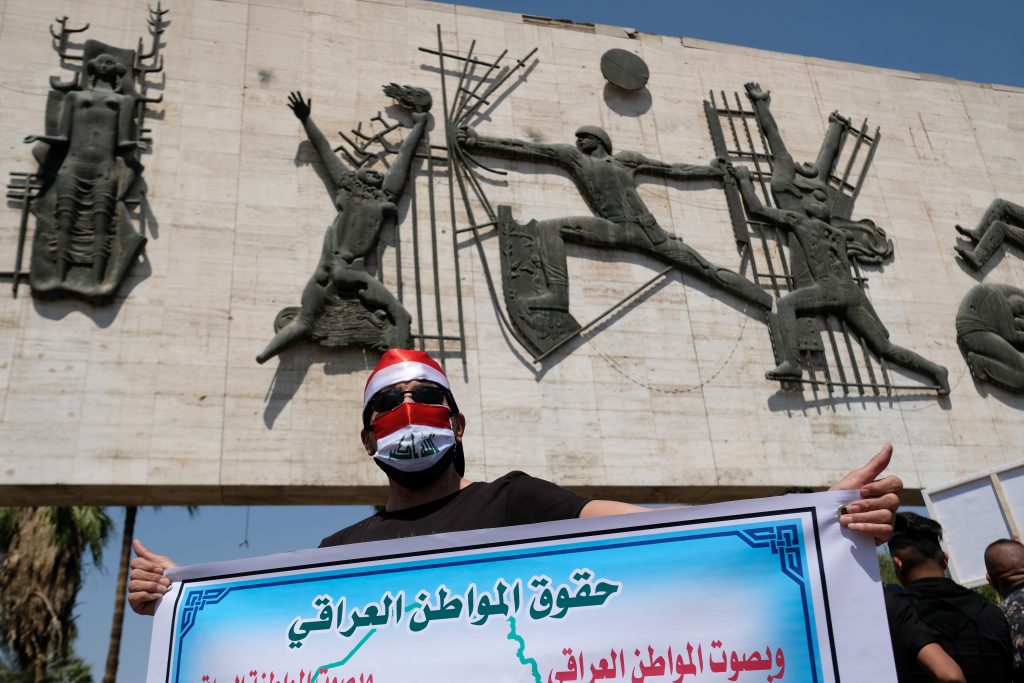
The protests led to the emergence, for the first time in recent history, of organized political opposition parties. The parties who boycotted the elections are particularly interesting, because they have been thinking about their long-term vision and ideology. They are trying to rebuild trust among the public in politics as an avenue for change. They think that the way to do this is to stay out of the current system and to run in elections in four years. In addition, what they think has been missing since 2003 is a sense of civic duty—they’ve advanced a new vision of politics being based on caring for the well-being and interest of your fellow citizens, instead of just looking out for yourself and your party.
The way that protesters have organized themselves in Iraq has been fairly similar to the organizational structures of protests against other regime types. The Iraqi protesters have reverted to horizontal and consensus-based forms of organization, which we often saw in protests against autocratic regimes that arose throughout the Arab world in 2010. I don’t think that the use of violence against protesters is unique to Iraq either.
I do wonder the extent to which the sort of overdetermination of sectarianism within the political system limits the political imagination. So much of the rhetoric being used by new opposition parties is very similar to that deployed by establishment politicians.
Jean: In Lebanon, groups like the Secular Club and Mada have had to be very agile and constantly adapt to new realities and needs. For example, structure and bylaws were not conceived in a strictly ideological way, but dynamically and pragmatically. The idea was to be inclusive and democratic, but also to deliver and be impactful. In terms of leadership, there was a flat organizational structure that also allowed leadership to emerge.
I am curious to know whether the leadership structures of the new opposition parties in Iraq are flat. In terms of social composition, is there a clear continuity between the actors in the 2015 protest movement against government corruption and the parties that emerged during the much broader and sustained anti-government protests in 2019?
Taif: There is a hierarchical organizational structure to these parties, and they’re not flat—which is different from how the protests are organized. However, the way that these parties are being organized is different from the way that the older parties were organized. There is an attempt to make sure that the new parties are democratic and that there is accountability. Many of them are holding elections for their membership to select who gets to be in various positions. In contrast, the dominant post-2003 parties got into power through family connections and their cooperation with foreign allies like the United States—their positions in politics were handed down through their lineage. The new parties are also quite interesting because they have representation in areas that were liberated from the Islamic State. This is interesting, because during the time of mass protests a lot of these people in Islamic State-occupied areas were not able to participate in them.
I think there is a clear break from the 2015 leadership, which was mostly concentrated in the Communist party. That party lost legitimacy after 2015 because of its alliance with conservative sectarian forces in parliament. In 2019, the protests were predominantly led by young men from poorer areas in Baghdad and southern Iraq, without any overt links to organized political parties.
Thanassis: There are some obvious common threads, and obvious differences, in what the stakes are for protests, depending on the characteristics of a regime. In democratic polities, for instance, protesters might assume that they won’t face long-term political consequences for their dissent—they probably won’t be barred from public sector employment, and if detained by authorities, probably won’t be convicted in a criminal court. On the other hand, across regime types, protest movements face violence from the authorities that they challenge.
Of course, the stakes are different from place to place. In Iraq and Sudan in recent times, and not long ago in Egypt, protesters were killed en masse by state authorities. In the United States and Lebanon, by contrast, protest movements faced violence from authorities and sometimes from thugs, but were not killed in large numbers by authorities.
I nonetheless suspect that in many ways the approach of protests often reflects the approach of the regime the protests oppose. In authoritarian contexts, protest movements tend to focus on specific accountability or governance demands—a change of leader, for instance, or an investigation of some specific abuses, or the addressing of a specific governance failure. In more open political systems, the demands and possibly the organization of the protests themselves can reflect wider, process-oriented possibilities: changes to the way elections are held, say, or unspecified and open-ended expansions of rights, or access to power for a marginalized group. And authoritarian systems, just like democracies, use co-optation strategies—offering protesters positions in the government that serve, over the long-term, to neutralize them.
Tom: If we zoom out and try to understand the global patterns of protest, we find that there is a general narrative that democracy is in crisis and there’s a kind of black cloud hanging over a lot of people around the world. If you look closely at it, you find that there are distinct things happening in very different parts of the world, which you can divide into three big zones.
First, you have a lot of countries that underwent democratic transitions in the 1980s and 1990s. There are two big patterns in the ways these countries are doing poorly. In one type of case, power-holders are consolidating power for power’s sake, without any overarching cause or program, and the institutions that might stop them are fairly weak. In the other type of case, power holders are drawing on accumulated citizen grievances, whether over corruption, insecurity, poverty, or other issues, and mobilizing those grievances as a justification for illiberal actions that override democratic guardrails.
A second part of the black cloud hangs over the established democracies. Unexpectedly, in the last ten years or so, they began having some serious issues with government corruption and the rule of law. They were having trouble for two reasons that are interwoven with each other. First of all, many of them have experienced a lot of sociocultural change—immigration and liberalization of social norms—and there was a big backlash that populist leaders took advantage of. The other thing is socioeconomic stagnation. In the last twenty years, the developed economies have been performing poorly for the middle and working classes.
The third type of regime under the black cloud is the autocracies, which have only become more autocratic over the past twenty years.
So, there are three main causes of protest in the world that cut across many types of countries. First, there is a lot of protest about political stagnation and overreach. Secondly, there are a lot of protests about corruption. Third, there are protests against economic injustice and marginalization.
Thanassis: What helps you to address de-democratization in young, threatened, democracies? Or, in more established democracies, to prevent democratic erosion that would shift them into the category of fragile democracies? You seem to have observed an absence of ideology in protest movements. Did you identify any surprising appearances of ideology?
Tom: In the first category of countries, where you have leaders who are taking power because they can, those leaders usually don’t really have a political program or ideology or a platform. In the case of countries where the grievances are driving illiberalism, it’s essential to help address the grievances—corruption, insecurity, poverty—because they are driving the illiberalism.
There are only a few ideologies left. You have ideologies of nationalism—there was a rediscovery of nationalism, after the cosmopolitan decade of the 1990s. And then you have ideologies of people who come in and say you have been cheated. And they bring in an anti-elitist ideology that has little content other than “we must smash the elites because the elites are the problem.”
Thanassis: I tend to distinguish between what I see as sympathetic, reform-driven protests, versus politically nihilistic or pro-authoritarian protests. Further, I distinguish between spontaneous, grassroots, organic protests and protests that are mostly funded and orchestrated in secret. But your broad survey forces me to ponder the commonalities that underlie mass protest, even when the stated goals are different. The leaders of an anti-vax protest in North America might not share a lot of goals with the leaders of Black Lives Matter, but the people who go out to protest share one thing in common: a conviction that they cannot exercise influence through the established political process.
That rigidity in the political process, it seems to me, is the cornerstone of the crisis in governance that drives the global frequency of protests. The other trend I look for, and don’t see as often as I’d like, is the consolidation of protest energy into standing political organizations that can exert power. Existing political forces—like the well-funded Far Right in the United States, or labor unions and opposition parties around the world—have used protest to mobilize support for or challenge authoritarian regimes. That’s different from the emergence of new coalitions or political demands through protests, like we’ve seen in the last decade in literally every region of the world. In the cases where protest channels otherwise unheard popular demands for rights, reform, accountability, regime change, whatever—I’ve looked for those protest movements to institutionalize and leverage their popular movement into some form that can seek power. For the most part I haven’t seen movements make this leap in the authoritarian states of the Middle East. In the United States and Europe, protest movements have, with some success, established beachheads of influence within mainstream political parties, but none to my knowledge has formed an enduring source of political power, whether in the form of a political party, a pressure group, or some other form that lasts beyond the protest cycle. In an era of broken, or at least unresponsive, political systems, I expect one of the next developments to be the emergence from protest movements of other types of organizations and structures that seek political power.
This report is part of “Transnational Trends in Citizenship: Authoritarianism and the Emerging Global Culture of Resistance,” a TCF project supported by the Carnegie Corporation of New York and the Open Society Foundations.
